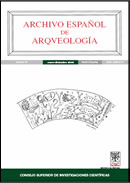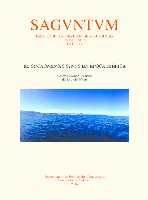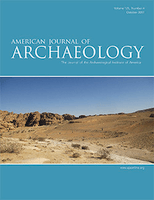
Archivo Espanol de Arqueologia
Scope & Guideline
Advancing archaeological knowledge through open access.
Introduction
Aims and Scopes
- Archaeological Excavations and Findings:
The journal frequently publishes detailed reports on archaeological excavations, providing insights into new discoveries and their significance in understanding the past. - Cultural and Historical Contexts:
Papers often explore the cultural and historical contexts surrounding archaeological sites, including social, economic, and political aspects of ancient civilizations. - Material Culture Studies:
The analysis of artifacts, such as pottery, glass, and inscriptions, is a core focus, highlighting their production, use, and role in ancient societies. - Interdisciplinary Approaches:
The journal embraces interdisciplinary methodologies, incorporating techniques from other fields such as anthropology, history, and art history to enrich archaeological interpretations. - Heritage and Conservation:
Research on the preservation and conservation of archaeological sites and artifacts is also a significant area, reflecting the journal's commitment to the protection of cultural heritage.
Trending and Emerging
- Environmental Archaeology:
There is a noticeable increase in studies examining the relationship between ancient societies and their environments, including investigations into resource management and ecological impacts. - Digital Archaeology and Technologies:
The application of digital tools and technologies, such as GIS and 3D modeling, is gaining traction, enhancing the analysis and presentation of archaeological data. - Social Archaeology:
Research focusing on social structures, identities, and interactions within ancient communities is on the rise, reflecting a growing interest in the lived experiences of past populations. - Archaeometry and Scientific Analysis:
The integration of scientific techniques, such as archaeometric analysis of materials, is increasingly prevalent, providing new insights into artifact production and use. - Cultural Heritage Management:
There is a growing emphasis on studies related to the management and preservation of cultural heritage, highlighting the importance of archaeology in contemporary society.
Declining or Waning
- Late Antique Studies:
Research specifically focused on the Late Antique period has decreased, possibly due to a growing interest in earlier historical periods or the transition to medieval studies. - Theoretical Archaeology:
Papers that emphasize theoretical frameworks or methodologies in archaeology appear to be less frequent, suggesting a possible shift towards more empirical studies and site-specific research. - Urban Archaeology:
While urban archaeology remains important, the publication of studies exclusively centered on urban sites has diminished, as the journal increasingly covers rural and peripheral contexts. - Ethnoarchaeology:
The application of ethnoarchaeological methods, which examine contemporary societies to inform archaeological interpretations of the past, seems to be waning in favor of more traditional archaeological practices. - Inter-regional Comparisons:
Comparative studies between different regions of the ancient world have become less common, indicating a trend towards more localized studies that focus on specific cultural contexts.
Similar Journals

Vjesnik Arheoloskog Muzeja u Zagrebu
Unlocking the Secrets of the PastVjesnik Arheoloskog Muzeja u Zagrebu, published by the ARHEOLOSKI MUZEJ & ZAGREBU, is a vital platform for disseminating scholarly research in the field of archaeology. With its Open Access model established in 2007, the journal ensures that vital archaeological findings and theories are accessible to a global audience, fostering greater collaboration and knowledge-sharing among researchers, professionals, and students. The journal is based in Croatia and has been an essential part of the academic landscape since its inception, with convergence noted in years such as 1979 and 1981, and continuing consistently from 2014 to 2023. While it currently holds a Q4 ranking in both the Arts and Humanities and Archaeology categories, its contributions to the understanding of archaeological heritage in the region are invaluable. Positioned within the 30th percentile among its peers in Scopus rankings, the journal endeavors to elevate the discourse around archaeological practices and findings, making it an important resource for anyone engaged in the pursuit of archaeological knowledge.

Revista de Arqueologia Historica Argentina y Latinoamericana
Advancing Knowledge in Historical Archaeology Across BordersRevista de Arqueologia Historica Argentina y Latinoamericana is a vital scholarly journal dedicated to the field of archaeology, with a particular focus on the historical dimensions of Argentina and Latin America. Published by the Assoc Professional Archaeologists Argentine Republic, this open-access journal has been enriching the archaeological discourse since 2007, making its valuable content freely accessible to researchers, professionals, and students around the globe. With an ISSN of 1851-3190 and an E-ISSN of 2344-9918, the journal aims to foster a deeper understanding of the archaeological heritage of the region by publishing innovative research articles, critical reviews, and methodological advancements in the study of historical archaeology. Positioned as a prominent platform for scholarship, it plays a crucial role in advancing archaeological knowledge while promoting interdisciplinary approaches within the field.

Archeologicke Rozhledy
Advancing archaeological scholarship for a global audience.Archeologicke Rozhledy, published by the Academy of Sciences of the Czech Republic, Institute of Archaeology, is a pivotal open-access journal dedicated to advancing the field of archaeology. Since transitioning to open access in 2019, it has made significant strides in disseminating high-quality research, serving as a vital resource for researchers, professionals, and students alike. With an ISSN of 0323-1267, the journal has gained recognition for its contributions in the domains of arts and humanities, particularly archaeology, as evidenced by its 2023 Q2 ranking in both categories. Operating out of the historical city of Prague, the journal encompasses a broad scope of archaeological scholarship, reflecting a commitment to interdisciplinary approaches and fostering dialogue within the global archaeological community. With its notable Scopus rankings—#115/413 in Arts and Humanities and #113/354 in Social Sciences—Archeologicke Rozhledy stands as a crucial outlet for innovative research and scholarly exchange.

Studijne Zvesti Archeologickeho Ustavu Slovenskej Akademie Vied
Unveiling the stories of the past through rigorous research.Studijne Zvesti Archeologickeho Ustavu Slovenskej Akademie Vied is a leading journal in the field of archaeology, published by the SLOVENSKA AKAD VIED, ARCHEOLOGICKY USTAV, based in Nitra, Slovakia. This esteemed journal, with the ISSN 0560-2793, has established itself as a vital resource for scholars and researchers, reflecting significant academic contributions in both the arts and humanities as well as social sciences. With a 2023 Scopus ranking placing it in the second quartile (Q2) for archaeology, it showcases rigorous research and innovative methodologies, essential for advancing archaeological studies. While it is not an Open Access journal, it continues to offer valuable insights into archaeological findings, theoretical frameworks, and interdisciplinary approaches. The journal serves as a bridge, connecting local Slovak archaeology with international discourse, making it an indispensable tool for students, professionals, and academics striving for a deeper understanding of the archaeological heritage of Slovakia and beyond.

Annales Instituti Archaeologici
Advancing Archaeological Knowledge Through Rigorous ResearchAnnales Instituti Archaeologici is a distinguished journal published by INST ARHEOLOGIJU, dedicated to advancing research in the field of archaeology. With an ISSN of 1845-4046 and an E-ISSN of 1848-6363, this journal serves as a vital platform for the dissemination of innovative archaeological studies and findings, reflecting the evolving trends and methodologies in this fascinating discipline. Based in Croatia, the journal captures a global audience, emphasized by its Q3 ranking in both Archaeology categories as per the latest 2023 metrics, indicating a solid presence in the academic landscape. Although it does not currently offer Open Access options, its impactful contributions are recognized through its Scopus ranks, where it stands at #137/413 in Archaeology related to Arts and Humanities and #135/354 in Social Sciences. Researchers, professionals, and students interested in the latest archaeological research and its applications will find Annales Instituti Archaeologici to be an invaluable resource, promoting knowledge and fostering scholarly communication within the archaeological community.

Prilozi Instituta za Arheologiju u Zagrebu
Exploring critical narratives in archaeology and history.Prilozi Instituta za Arheologiju u Zagrebu is a prominent academic journal published by INST ARHEOLOGIJU, dedicated to advancing the field of archaeology and related historical studies. Operating in Croatia, this journal serves as a vital platform for scholars, researchers, and students to disseminate innovative research and insights within the realm of archaeology, with a focus on the rich cultural heritage of the region. The journal spans contributions from 2002 to 2011 and has ongoing publication since 2013, reflecting its commitment to contemporary archaeological discourse. With a growing reputation, it has achieved a Q3 ranking in the fields of Archaeology and Arts and Humanities, and a Q2 ranking in History, signifying its impact and relevance in the academic community. Although Open Access options are not available, the journal remains an essential resource for those pursuing in-depth knowledge and research in archaeology. Researchers can harness the journal's extensive scope to explore critical historical narratives and archaeological findings, solidifying its importance in both local and global contexts.

SAGVNTVM-Papeles del Laboratorio de Arqueologia de Valencia
Unlocking the Past: Where Archaeology Meets Innovation.SAGVNTVM-Papeles del Laboratorio de Arqueologia de Valencia is an esteemed open-access journal dedicated to advancing the field of archaeology, published by the Department of Prehistory and Archaeology at the University of Valencia, Spain. With an ISSN of 0210-3729 and an E-ISSN of 2174-517X, the journal has been a vital resource for scholars since its inception in 1962, ensuring that high-quality archaeological research is readily available to the global academic community. Notably, it holds a distinguished Q2 ranking in both Archeology and Archeology within the arts and humanities categories as of 2023, reflecting its commitment to rigorous scholarship and significant contributions to the field. The journals' Scopus rankings further affirm its relevance, positioned at #188 of 413 in Arts and Humanities and #179 of 354 in Social Sciences. Researchers and professionals alike can delve into a variety of topics, benefiting from the journal’s rich archive from 2017 to 2023. With a mission to disseminate knowledge and foster dialogue in archaeology, SAGVNTVM serves as an essential platform for investigators, students, and practitioners interested in the latest archaeological findings and methodologies.

AMERICAN JOURNAL OF ARCHAEOLOGY
Connecting Cultures Through Archaeological DiscoveriesThe American Journal of Archaeology (ISSN: 0002-9114, E-ISSN: 1939-828X), published by the esteemed University of Chicago Press, stands as a leading scholarly journal in the field of archaeology, celebrated for its rigorous peer-reviewed research. With an impressive impact factor that places it in the Q1 quartile for both archaeology and archaeology within the arts and humanities, this journal ranks among the top 15% in its field, according to Scopus metrics. It serves a global audience of researchers, professionals, and students, facilitating the dissemination of innovative findings from excavations, historical analyses, and methodological advancements. While primarily available through subscription, the journal's archives and features provide invaluable resources for deepening one's understanding of the past and engaging with current archaeological discourse. Operating from its home in Chicago, USA, the American Journal of Archaeology actively contributes to the advancement of knowledge and scholarship in archaeology, making it an essential platform for those invested in the exploration of ancient civilizations and cultural heritage.

Cuadernos de Prehistoria y Arqueologia-Universidad Autonoma de Madrid
Connecting Researchers to the Rich Tapestry of HistoryCuadernos de Prehistoria y Arqueologia-Universidad Autonoma de Madrid is a distinguished academic journal dedicated to the fields of archaeology and prehistory, published by the Universidad Autonoma de Madrid, Departamento de Prehistoria y Arqueología. With an ISSN of 0211-1608, this journal plays a crucial role in disseminating significant research findings and theoretical advancements within these domains. Recognized for its scholarly excellence, it holds impressive quartile rankings in 2023, including Q2 in Archaeology and Q1 in History, reflecting its high impact within the academic community. While currently not an open-access publication, Cuadernos de Prehistoria y Arqueologia provides valuable insights to researchers, professionals, and students engaged in the exploration of human history and cultural heritage from 2018 to 2024 and beyond. With a commitment to fostering interdisciplinary dialogue, this journal serves as an essential platform for innovative studies and comprehensive reviews, contributing to the advancement of knowledge in archaeology and prehistory.

OLBA
Advancing Knowledge in the Field of ArchaeologyOLBA is a distinguished journal in the field of archaeology, published by Mersin University Publications Research Center Cilician Archaeology in Turkey. With an ISSN of 1301-7667, this academic journal has been a platform for scholarly discourse from 2009 to 2014 and again from 2016 to 2019, with a recent volume published in 2022. Although it is currently categorized in the fourth quartile (Q4) for both Arts and Humanities and Social Sciences within archaeology, OLBA continues to contribute significantly to the global archaeology community. It serves as an essential resource for researchers, professionals, and students interested in the diverse aspects of archaeological studies and cultural heritage. Despite not being an open-access journal, OLBA strives to disseminate knowledge effectively, aiding in the exploration of ancient civilizations and the rich tapestry of human history. Its Scopus rankings, placing it in the bottom percentiles, demonstrate the ongoing need for the community to support and engage with the journal to enhance its visibility and impact in the archaeological domain.